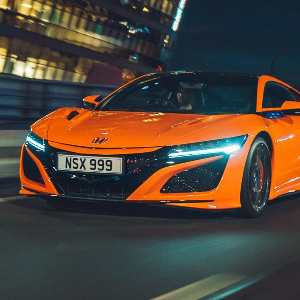
Criminally underrated at its launch, can Honda’s Ferrari fighter relight the fire with an updated model?
Pros:
+ Incredible performance regardless of road conditions
+ Looks every inch a genuine supercar
+ One of the most approachable supercars money can buy
Cons:
- Not the most practical supercar out there
- Turbocharged V6 not as tuneful as V8 or V10 rivals
- Infotainment is shockingly bad
Verdict: While those chasing badge kudos will look away from humble Honda, the NSX is a true flag barer for what the Japanese marque is capable of. Sure, it might lack some of the theatre of a Ferrari F8 Tributo, but this supercar has the measure of it on wet and broken British Tarmac. In the real world there is very little that will outpace an NSX point-to-point.
2021 Honda NSX: five-minute read
A few cars are somewhat misunderstood when they hit the road, something that often leads to them being criminally underrated. The Honda NSX is one such victim with critics suggesting that it’s too pricey or lacks the thunder of something Italian. However, these people forget what NSX stands for – New Sportscar eXperimental – a machine designed to push boundaries. Considering that if you wanted a hybrid supercar back in 2016, you needed a million quid for a LaFerrari or McLaren P1. The reborn NSX brought this high-performance tech to people not spending seven figures.
This is the freshly updated NSX, and in true Honda fashion, it’s about refining an already successful formula. On the surface you’re greeted by new Thermal Orange paint, but the same origami-inspired creases that makes for a machine that could well be a robot in disguise. Narrow banks of headlights stare right back at you, while neat ducts and vents serve to manipulate airflow. It’s a dynamic and distinctive think to look at, but also not so aggressively styled that it’s offensive. You can option contrasting carbon elements, the rear lip in particular, something that looks great with graphite alloy wheels.
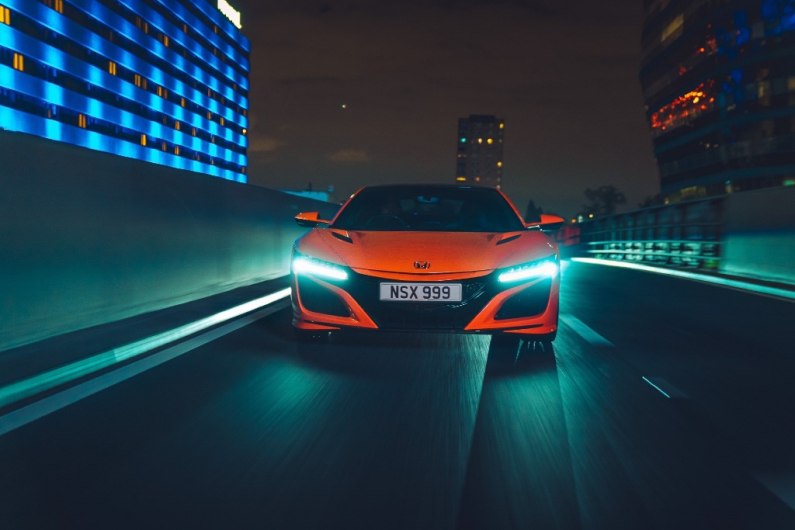
Honda have taken a pragmatic approach to the interior, although the blue hue of our test car’s upholstery is far from sober. There are two sizeable sport seats at the heart of this cockpit, shapely but broad for a more cosseting GT seat than an over-bolstered affair. You sit low with a farther sculptural centre console dividing you. Material quality is great with brushed aluminium, fine leathers and some nice Alcantara touches. If you know your Hondas, you might be a little disgruntled by the use of some switchgear also found in Civics, but there is a durable feel to this interior – it’s far from delicate and dainty. What’s less forgivable is the infotainment system that is straight out of a Honda Jazz, is slow, difficult to use and about as graphically rich as the original PlayStation. Its saving grace is Apple CarPlay and Android Auto compatibility.
While we’re talking negatives, boot space is a real Achilles’ heel with there being no frontal compartment to this mid-engined car. The boot is located at the rear and on top of the gearbox, making this 125-litre space quite warm. It’s big enough for a couple of small bags, but can’t match the Audi R8 or Porsche 911 Turbo for practicality.
Niggles aside, the Honda NSX is a truly remarkable machine, combining a twin-turbocharged 3.5-litre V6 engine with a trio of electric motors. The net result of this coming together of old and new worlds is truly astonishing. Set to maximum attack, the NSX’s electric motors are the first things to engage providing instant response while the engine spools to deliver its potent performance. A 0-62mph run of just three seconds highlights what an advantage having batteries onboard can be. The NSX will continue to pull with the same enthusiasm to a top speed of 191mph. Its rapid nine-speed dual-clutch gearbox will happily keep pace with the action, too.
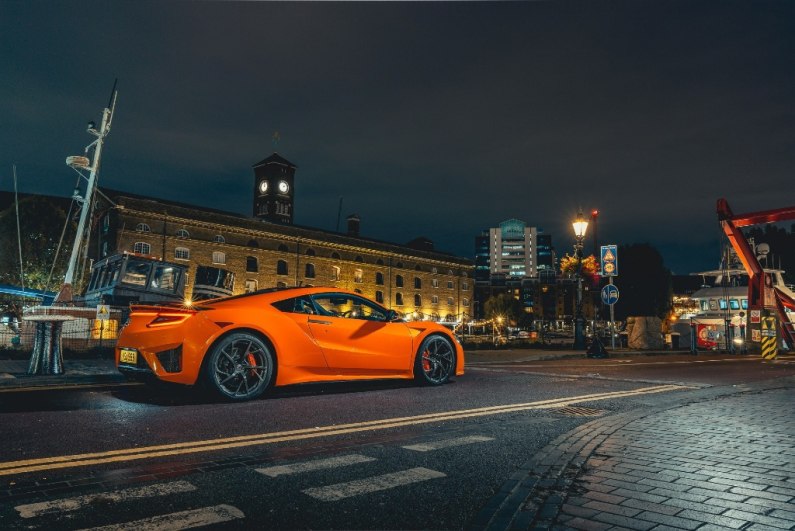
All-wheel drive is not only a byproduct of all the techno-wizardry under the skin, but is actually a huge asset to the NSX in the real world. A total of 573bhp is a lot of potential to place on the Tarmac, and here in the UK all the more so. Stickier Continental Contact 6 tyres and an incurable amount of computing power claw grip in conditions that would see most supercar stay at home, and intelligent torque vectoring shuffling power around makes for an incredibly stable platform. However, this is no computer game as the NSX is a surprisingly involving thing to drive in today’s digital age. You get great feedback from the chassis, and the is car happy to break traction in a predictable manner if requested.
This model was ahead of its time when first launched, but a lot of Top Trump players zeroed in on the weight and power. Ultimately, it’s children that play such games, and those who really appreciate great engineering will adore the NSX. Its changes for this model year might be small, but its steering and suspension tweaks are of note when pushing on. It remains a highly impressive package that deserves more attention than it currently enjoys.
2021 Honda NSX practicality and boot space
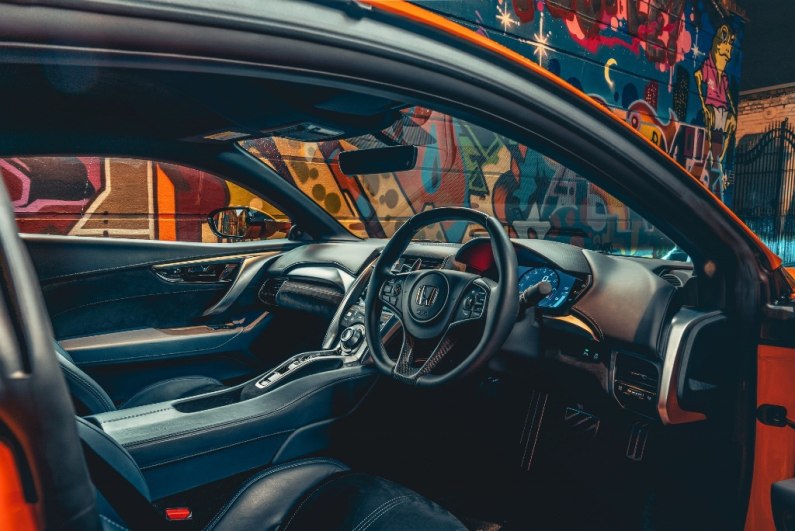
Nobody is primarily buying a supercar for practicality – no matter how hard you try, you’ll never fit five kids and a pushchair in one. However, the dawn of the everyday usable supercar was some time ago now, something that arguably started with the original NSX. Since then practical Porsche’s have been granted the title of supercar and Audi’s R8 is usable enough for most buyers today, so where does that leave this next NSX?
Sadly, being a victim of its own success. You see, to pack a twin-turbocharged V6 engine and three electric motors into this car required some creativity. There’s no point trying to put a bag in a front storage compartment because that is full os mechanical gadgetry, so the NSX loses out there. There is a 125-litre boot behind the engine and on top of the gearbox, but as you can imagine, things get quite hot back there. A weekend away will result in a few small bags squeezed into the boot and maybe your passenger clinging onto the coats. There’s good storage around the cabin with various cubbies and a good size glovebox, but its fair to say that rivals have the edge.
Something the NSX can do better than just about any other car in this class is put the driver at ease. Living with a supercar involves lots of worrying if you’re going to fit through gaps or fearful of Instagramers hiding in blindspots. Thanks to a cockpit with thin pillars, large windows and a set or sizeable door mirrors, much of that stress is absent. Also, the protruding mirrors give you a great view of the car’s very cool shoulder-mounted intakes.
2021 Honda NSX engine
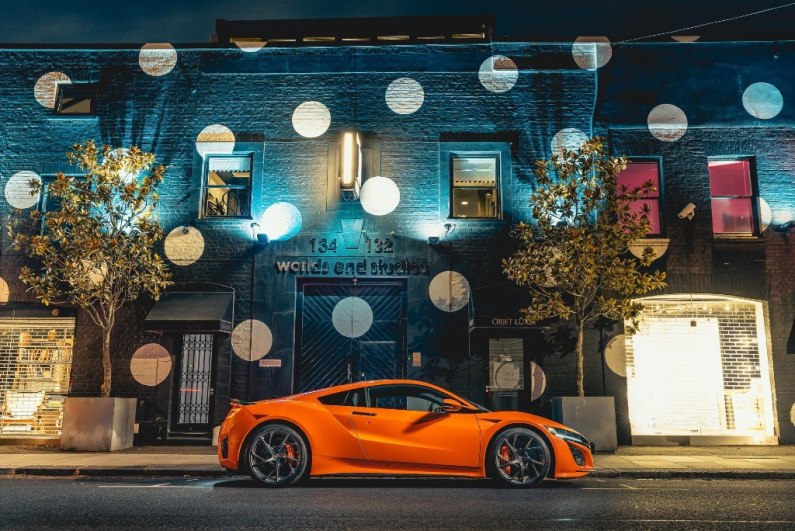
What makes the NSX rather unique is its drivetrain. A more traditional V6 petrol engine is fused with a trio of electric motors and a battery. To highlight how ahead of its time this was for the class, keep in mind that it has taken McLaren and Ferrari another 5 years to bring something similar to a more ‘mainstream’ series of car.
There are a pair of electric motors up front, and one at the rear with the 3.5-litre engine. The beauty of this collaboration is that while the engine builds its performance, the electric motors can fill the gap immediately upon request. That means no delay and throttle responsiveness unlike almost anything else. Factor in that the car is all-wheel drive, and has launch control, a combination that enables breathtaking sprints from a standstill are yours to repeat at leisure.
The surge of torque is relentless as the engine is seamlessly fed into the ‘go faster’ equation. It’s not the most sonorous sounding combustion engine, but its purposeful and narrated by induction noise. Regardless of how it sounds, the way it functions will leave you in no doubt that this is a true supercar. Its rapid nine-speed gearbox deserves some attention of its own as it’s brilliant. You’d be surprised how many lacklustre ‘boxes you’ll find in six-figure cars, but this is not one of them. It’s decisive and responsive when driving at a pace, but sleek and subtle when cruising.
If you don’t think a turbocharge V6 sounds all that exotic, consider that Honda plasma transferred wire arc thermal spray to coat its cylinder walls. Does it get any more sci-fi?
2021 Honda NSX driving
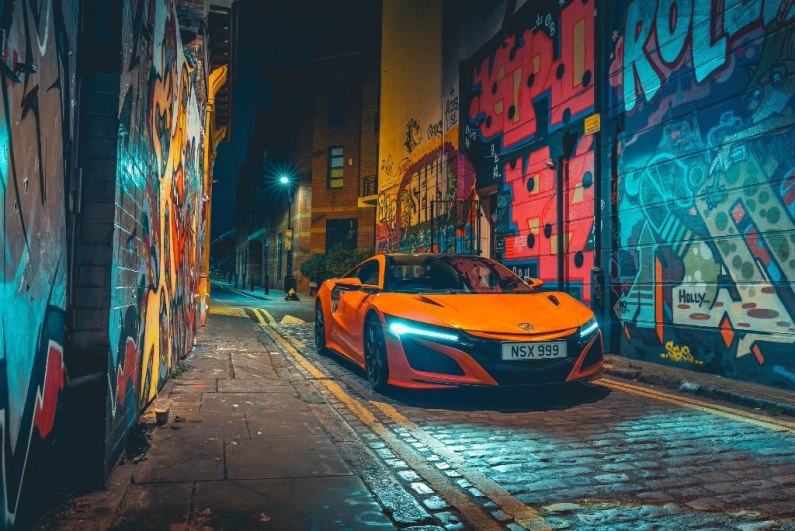
Let’s say it is 7am and you’re hoping to quietly slip out of your underground garage without waking the neighbourhood. Not really a supercar’s modus operandi, right? Well, amazingly the NSX can cover short distances on electric alone despite not having a dedicated EV range or plug to charge the car. It can store energy otherwise lost through braking in its battery for use on such occasions. It’s a strange sensation for a machine with such road presence to silently glide on past when in town.
In ‘Sport Mode’, the NSX’s default setting, you can really appreciate what a brilliant car this is to live with every day. Yes, you can sense the performance waiting to be unleash beneath your right foot, but more is impressive how seamless the transition between petrol and battery power. Peugeot struggle to do this with an SUV, but here’s Honda nailing it on a machine far more highly strung and complex. The NSX flits between power sources continuously dependant upon your behaviour and what the battery status is. Its engine feeds in with refinement, and the electric motors are ready at the drop of a hat should instantaneous momentum be required. Then there’s the surprisingly compliant ride and wonderfully predictable steering that need just the tiniest of inputs to respond. Driving the NSX daily is a wonderfully natural experience, and far from tedious like some other supercars.
Select ‘Sport Plus’ from the big rotary dial and the NSX really comes to life as the car knows you’re looking to play. Hit the twisty stuff and relish its composure through tightening bends, and then synapse singeing responses when it is time to come back on the power. Stiffer anti-roll bars, fettled dampers and other small suspension tweaks don’t sound like much on paper, but they add an extra sheen of incisiveness to the way this car changes direction. Considering it weighs 1.8 tonnes, it feels very light on its feet. The optional carbon brakes on our test car also served as a great companion on challenging roads, being easy to modulate and providing a reassuring resistance.
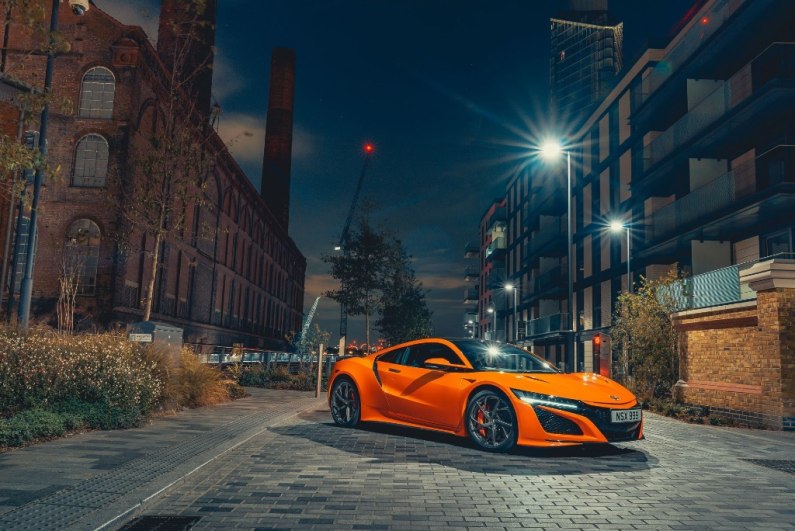
The NSX is at its most impressive on a typical British day where the roads are greasy after a good prescription of rain. This is a classic supercar killing surface that sees all too many parked in ditches. Not only does the all-wheel drive distribute torque in a way that inspires confidence, but you can actually feel the car at work beneath you. This is by no means a spectator sport as the NSX can easily be encouraged to move around, but the telepathic nature of how this car responds to your inputs always makes you feel in control. It will happily cross country at a faster clip in these conditions than anything from Italy that you’ll have to temper at every turn.
‘Track Mode’ tightens everything up and delivers the most ferocious response from the drivetrain. It really is staggering just how fast this thing is – obvious comment about a supercar, I know. Launch Control is active in this mode, and once you’ve set off like a scolded cat, the car’s precision in how it goes about calving up corners is remarkable. Just note that this mode also turns off many of the driver aids, so think carefully before using it on the road.
There are more theatrical supercars out there, more engaging ones to drive too, but like owning a pet dragon, the novelty of something permanently straining at the lead can become tiresome. The Honda NSX is a car you’d happily drive to the shops before taking the very long way home. Its technological package remains rare in the world of mid-level supercars, and the NSX’s willingness to use it highlights the advantages to be reaped.
